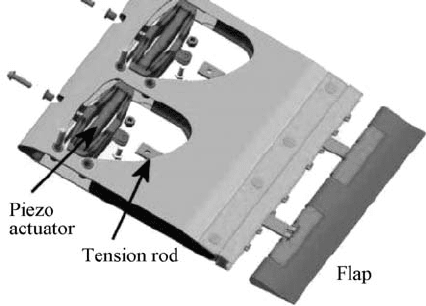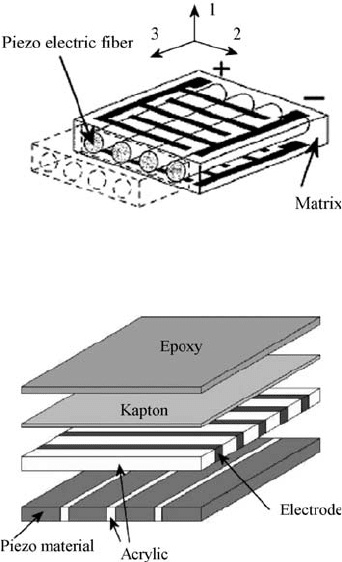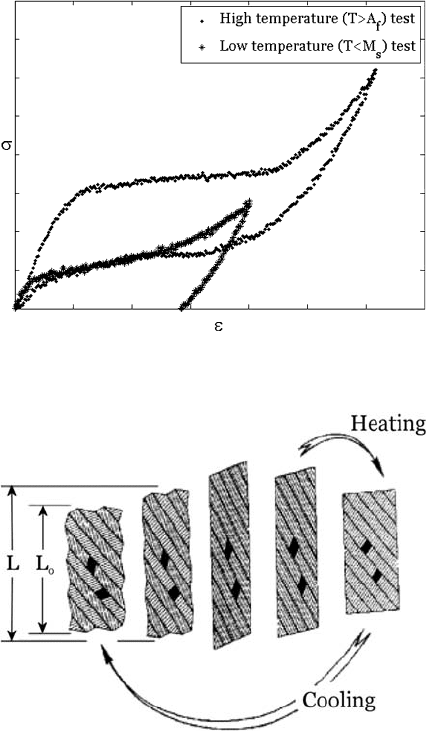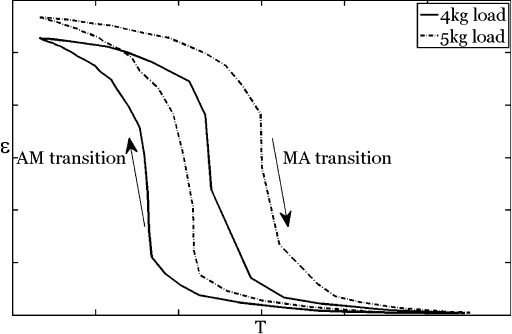Tong W. Wind Power Generation and Wind Turbine Design
Подождите немного. Документ загружается.

Implementation of The ‘Smart’ Rotor Concept 475
allowed for a high rate, continuously deforming trailing edge in both cordwise and
spanwise direction. As a base structure the same construction as the trailing edge
fl aps, but aramid instead of aluminum honeycomb were used. The piezoelectric
motors were chosen because of their high power-to-weight-ratio. Interesting con-
clusions from the program were that active surfaces can indeed be employed but
that the actuation bandwidth of SMA material is very low and that the technology
readiness level [ 49 ] was around fi ve [ 25 ]. This means that it is at the level of com-
ponent and/or breadboard validation in a relevant environment. This point is also
addressed by Boller [ 50 ]: adaptive structures have shown great potential over the
last 20 years, but only little real structural implementations have been achieved.
The overview of all these concepts of ‘smart’ wings leads to some refl ections.
First of all, a distinguish between different amounts of required deformation can
be made: vibration control requires the littlest deformation of the structure since it
means controlling the stiffness of a structure through stressing, or actively coun-
teracting the vibration with a force. For wing twist medium strains are required
because the resulting twist results from the accumulated strain along the blade's
span. For integrated control surfaces relatively large strains are needed. This is
also illustrated by the fact that many studies focus on the use of servo or servo-like
actuators and that often silicone or latex skins are employed to allow for large
strains in the skin, e.g., [ 48 ]. Classical concepts mentioned by Campanile [ 21 ]
often employ surfaces that slide over each other.
Another distinction can be made in the different speeds required for actuation.
Active vibration control requires very high actuation frequencies, whereas recon-
fi guration is quasi-static. Concepts for fl ight control require medium actuation
speeds which are similar to the current control surfaces. Thirdly, for all adaptive
concepts, but especially with wing twist, a trade-off must me made between on
one hand the possible weight reduction due to the integration of several functions
in one structure and on the other the added actuator mass. A fi nal consideration is
the readiness of the technology.
2.2 Smart helicopter rotor blades
A great deal of research on adaptive (aero)elastic structures has been conducted
in the fi eld of helicopter rotors. The research has been into different features
such as torsion tubes, active twist control, trailing edge fl aps, etc. Straub presents
a good overview of early concepts [ 51 ]. In the following they are grouped and
discussed.
2.2.1 Trailing edge fl aps
Although helicopter rotors are much smaller than wind turbine blades and operate at
much higher rotational speeds, they still pose an interesting benchmark as adaptive
structures primarily because the structure under consideration is also a rotor. Sec-
ondly, because the intended effect, obtaining vibration reduction through load con-
trol, is usually the same. And fi nally because the fl ap defl ections that are aimed at are
roughly the same [ 9, 52 ], viz. several decrees for a fl ap size of ∼ 10% of the cord.

476 Wind Power Generation and Wind Turbine Design
There are several ways at which the fl ap can be controlled by adaptive materials.
The following are elaborated in literature. Lee and Chopra [ 53 ] proposes a so-called
piezo-based ‘double L’ amplifi er. This mechanism drives the fl ap. Enenkl [ 54 ] pro-
posed a similar system which consists of a piezo stack between two leaf springs. The
Enenkl concept (see Fig. 6 ) has been tested on a full-scale helicopter rotor.
Bothwell [ 52 ] elaborates on a magnetostrictive driven torsion tube but he also
mentions SMA wires for twisting the tube. Other torsion tube options [ 55 ] use
pure piezo tubes by evoking twist in the piezo ceramic elements. Another way to
drive the fl ap would be to employ the piezo ceramic in a bender and to use that
bender to actuate the fl ap close to its hinge, thus amplifying displacement induced
by the bender [ 56 , 57 ]. A fi nal application is to use SMA wires to pull the fl ap in
either direction [ 58 ].
All these helicopter rotor trailing edge concepts are based on hinged fl aps. This
is not wanted in wind turbine rotor trailing edge fl aps because of maintainability
issues. Helicopters are already subjected to mandatory, regular inspections and
rotor blades are replaced regularly.
2.2.2 Active twist
With helicopter blades another option has been researched, although less thor-
oughly than trailing edge fl aps. This is to twist a section of the blade to infl uence
the aerodynamics. Such a system could theoretically replace the cyclic pitch sys-
tem, but the defl ections are not large enough, so the goal remains vibration control
[ 59 ]. With active twist a piece of the blade at the root can be twisted. Two technical
implications can be distinguished. One is to apply adaptive materials under an angle
to induce shear and thus torque. The second one is to apply an angled laminate with
longitudinal applied adaptive materials. This induces the same type of shear. Pos-
sibilities are mentioned by Chopra [ 56 ], Strehlow and Strehlow [ 60 ] and Barrett
et al. [ 59 ]. Barrett makes a comparison for different twist inducing confi gurations
Figure 6: The piezoelectric stack driven concept by Enenkl (fi gure adapted
from [ 54 ]).
Implementation of The ‘Smart’ Rotor Concept 477
for a fi n [ 61 ] and later to a small helicopter rotor [ 59 ]. But according to Boller [ 50 ]
the solution is only applicable to small rotors.
As with concepts for smart wings, some general considerations can be deducted
from this. The fi rst one is that generally the goal of adding smart features to heli-
copter blades is vibration control and sometimes quasi-static blade tracking. But
not replacing the current fl ight control system. For vibration control most research
is aimed at active twist or trailing edge fl aps, actuated by piezoelectric driven
mechanisms. With piezoelectrics high actuation frequencies are attainable.
3 Adaptive materials
In the previous section on aerodynamic features, two types of adaptive materials
are repetitively implemented: piezoelectrics and SMA material. Others can also
be discarded for adaptive features on wind turbine blades because of the need for
heavy coils (magnetostrictives, magneto-rheological fl uids), too low bandwidth
(electroactive and SMPs).
3.1 Piezoelectrics
Piezoelectric materials exhibit a coupling between mechanical deformations and
dielectric effects. Actually, the term piezo is derived from the Greek word for
squeeze or press. Moreover, the piezoelectric effect was fi rstly discovered in crys-
tals which gave of a surface charge when strained. This is known as the direct
effect. But the effect also works in the inverse manner: the material will strain
under the application of an electric fi eld. This is known as the converse effect.
These effects, as well as the governing equations have been documented by
many [ 62– 67 ]. They can be written in many forms [ 62 , 66 ], depending on the
electric and mechanical boundary conditions, but here they have written in two
forms which are relevant to the use of actuator and strain sensor and the appropriate
constants that describe the material will be discussed:
E
iijj mim
SdEs=+e
( 1 )
mmiiikk
Dd eE
s
s=+
( 2 )
with: i,j =1,2…,6 and m,k = 1,2,3 The subscripts are related to the material's coor-
dinate system and the superscripts denote under which constant boundary condition
the parameter is assessed – s for constant stress and E for constant electric fi eld. In
eqs (1) and (2) the following variables defi ne the electric and mechanical state of
the piezoelectric materials.
e
i
: Strain component.
s
i
: Stress component.
D
i
: Electric displacement component. Electric displacement is related to the amount
of charge q on the electrodes: q = Ú Ú DdA
E
i
: Applied electric fi eld component.

478 Wind Power Generation and Wind Turbine Design
The other symbols are the piezoelectric constants and they are defi ned as
follows:
e : Permittivity. It is the electric fi eld per unit applied electric displacement. e is
often related to the permitivity of vacuum: 8.85 × 10
–12
F/m
d : matrix of piezoelectric charge constants. It is the mechanical strain per
unit applied electric fi eld or the electrical polarization per unit mechanical
stress applied.
S : Elastic compliance constant which is defi ned as the amount of strain in the
material per unit applied stress.
There are many ways to rewrite these equations into other forms. The IEEE [ 62 ]
and Moulson and Herbert [ 66 ] present a good overview. These are chosen here
because eqn (1) is very useful in describing the behavior of piezo-electrics as actu-
ator and eqn (2) as sensor. Moheimani and Fleming [ 63 ] describes very well how
these equations can be applied to patches and Waanders [ 64 ] to stacks. Another
very important piezoelectric parameter is the effective coupling coeffi cient, k ,
which is a measure for the ability of the material to convert mechanical energy in
electrical energy, or vice versa:
2
converted energy
input energy
k =
(3)
k can also be expressed in terms of piezoelectric constants described above:
2
ij
ij
ES
ij ij
d
k
s e
=
( 4)
However, the total effi ciency of a piece of piezoelectric material is not only defi ned
by k , but also by the way it is incorporated into a mechanical system. Giurgiutiu
and Rogers [ 68 ] defi ne r as the ratio between the (internal) stiffness of the piezo-
electric material and the (external) stiffness of the structure against which it acts,
and then derives that the total energy conversion coeffi cient equals:
2
2
(/ 1
1
4
1)rkr
k
h
⎛⎞
=
+
⎜⎟
−
⎝⎠
( 5)
Note that this equation holds for low frequent and quasi-static applications. Many
dynamic analyses [ 64, 66 , 68 ] of piezoelectric materials in electro-mechanical
systems exist.
3.1.1 PZT
PZT, or lead zirconium titanate, is the most widely used piezoelectric material.
It is a very brittle ceramic. Below the Curry temperature the ceramic crystal
exhibits a lattice structure with a dipole because of tetragonal symmetry. Crys-
tals with adjoining dipoles are grouped in domains, called Weiss domains, which
are randomly orientated in the material. Therefore the material has no net dipole.
Implementation of The ‘Smart’ Rotor Concept 479
However, applying a high electric fi eld just below the Curie temperature lets the
domains which lie in the fi eld direction grow at expense of others. This operation
is called poling and causes a net dipole in the material. The matrix of piezoelectric
strain constants is of the form:
15
15
31 31 33
0 0 0 0 0
0 0 0 0 0
0 0 0
d
d
ddd
⎡⎤
⎢⎥
⎢⎥
⎢⎥
⎣⎦
( 6 )
In the case of a patch, the three-direction denotes the out of plain and poling direction
and d
33
is much larger then d
31
. 4–6 denote shearing. Specifi c forms and applications
of PZT are discussed later.
3.1.2 PVDF
PVDF, or polyvenyldiphosphate, is one of the many polymers that can exhibit
piezoelectric effects. It is discussed here because it has the highest coupling coeffi -
cient and already applications exist. Still, the coupling is much lower than the PZT,
but a big advantage of PVDF is that it is very ductile. Making PVDF piezoelectric
requires two steps: obtaining the right crystal structure and secondly, obtaining the
net dipole. There are numerous ways to get to a piezoelectric form, but since most
available materials consist of so-called phase II form, the following procedure is
suggested [ 69 ].
The fi rst step, obtaining the right crystal structure, is performed by stretching
the material at elevated temperature after which it recrystallizes in phase I. This
form has a non-centrosymmetric crystal, and thus a dipole. However, the crystals
are still randomly orientated. Subsequent poling can be achieved by applying a
high electric fi eld from a corona at room temperature or a relative low fi eld at
elevated temperature. When poling, the PVDF's constitutive units are rotated
around their chain bonds and thus a net dipole is attained. Hundred percent align-
ment with the fi eld is not possible because some of the chains my have a vector
component in the poling direction.
For piezoelectric PVDF sheets the charge constant d which links a fi eld in the
out of plane poling direction to in-plane strain, is different for both in-plane direc-
tions: d
31
≠ d
32
and d
51
≠ d
42
, because of the uni-axial stretching. Therefore the
charge constant matrix has the following form:
15
24
31 32 33
0 0 0 0 0
0 0 0 0 0
0 0 0
d
d
ddd
⎡⎤
⎢⎥
⎢⎥
⎢⎥
⎣⎦
( 7 )
The charge constants, the coupling coeffi cient and the compliance of PVFD are
much lower than those of PZT, but it is much easier to handle and less brittle. In
addition, PVDF with PZT granules dissolved in them have been proposed already
years back [ 70 ]. This boosts the piezoelectric coupling, while maintaining the duc-
tility of PVDF. However, Furukawa shows that the piezoelectric functionality of
the composite can mainly be attributed to the PZT part of the composite.

480 Wind Power Generation and Wind Turbine Design
3.1.3 Single crystal piezoelectrics
A fi nal possible alternative is called Langasite [ 33 ]. This is a piezoelectric crystal
that is grown under very high pressure. The crystal has a lower coupling coeffi -
cient than PZT, but a very high Curie temperature and depolarization fi eld. Thus,
when high voltages are applied, similar performances can be attained. It is also
much less brittle and lighter than PZT. However, the crystal is very limitedly avail-
able and more expensive than PZT. The structure of the d-matrix is as follows:
11 12 14
25 26
0 0 0
0 0 0 0
0 0 0 0 0 0
dd d
dd
⎡⎤
⎢⎥
⎢⎥
⎢⎥
⎣⎦
( 8)
Bohm et al. [ 71 ] reports that due to the symmetry of the crystal, only two param-
eters are independent. Usually d
11
and d
14
are mentioned.
3.1.4 Piezoelectrics as actuators
Because the coupling between a fi eld in the poling direction is the strongest, it is
most obvious to employ this effect. But since the mutual distance between elec-
trodes must remain small to attain a high electric fi eld for a given voltage, special
confi gurations have been developed for employing the d
33
-effect. First of all, one
can stack a series of disks or small patches on top of each other, each patch with
its own set of electrodes. This is called a ‘piezo stack’ (see Fig. 7 ). By applying
the same voltage to each patch, a high fi eld in the poling direction is attained
and because the dimension of the piezoelectric material in its poling direction is
increased, so is its displacement. However, the displacements are still very small;
a typical stack of several centimeters can only attain displacements in the order of
magnitude of 10
2
μ m . But large forces can be exerted this way.
Another concept in which the d
33
-effect is implemented, is the embedding of
fi bers that are poled in their longitudinal direction in a polymer with the applica-
tion of interdigitated electrodes on the surface. These materials are called active
fi ber composite [ 73 ] (see Fig. 8) . Because these electrodes are placed at small
instances, a high electrical fi eld in the poling direction per unit applied voltage is
attained. These plies can in turn be embedded into fi ber reinforced polymers.
Figure 7: Piezo stack confi guration (fi gure adapted from [ 72 ]).

Implementation of The ‘Smart’ Rotor Concept 481
A special type of these active fi ber composites are called macro fi ber composites
(MFC’s) [ 74 ] (Macro Fiber Composites), developed by NASA. MFCs are pro-
duced by sawing very fi ne strips from a patch and embedding those in epoxy
between Kapton fi lm (see Fig. 9) .
Another way to amplify the displacement of a piezo-based actuator is to apply
sheet material in a bender, either as a unimorph, with a patch on one side, or as a
bimorph with a patch on each side. This way, the small strain of the piezo patch
can be used to induce relatively large defl ections of the bender. The behavior of
such a bender is quite accurately described by extending the classical laminate
theory (CLT) with piezoelectric effects analogous to thermal expansion. But other
models which incorporate out-of-plane shear have also been developed [ 72 ]. When
applying piezo patches in laminates, one must be aware that a piezo patch strains
in all in-plane directions when a fi eld is applied. However, usually straining the
construction or substrate in one direction is wanted. Barrett et al. [ 75 ] therefore
introduced the enhanced directionally attached piezoelectric (EDAP). With the
concepts, narrow strips or special adhesion strategies are used to exploit the
induced strain in only one direction.
Figure 8: The principle of active fi ber composites (fi gure adapted from [ 72 ]).
Figure 9: The build-up of a MFC (fi gure adapted from [ 74 ]).
482 Wind Power Generation and Wind Turbine Design
There are also ways of increasing the defl ection of these benders. This is done
by introducing a geometrical non-linearity by axially compressing the bender [ 76 ]
or using the thermal mismatch between the plies to introduce an internal stress
state. Two types of benders that make use of the thermal mismatch are called
Thunders [ 77 , 78 ] and lightweight piezo ceramic actuators (LiPCA’s) [ 79– 81 ].
The Thunder actuators consist of a piezo ceramic sheet that is laminated between
a thin steel plate and an even thinner aluminum foil by means of an adhesive. This
laminate is consolidated at about 300°C and when it cools, the difference in coef-
fi cient of thermal expansion (CTE) causes a bend, and even slightly domed shape
of the bender, depending on the aspect ratios and the presence of tabs. Aimmannee
presents a model [ 78 ] which accurately predicts the shape of the Thunder. LiPCAs
are based on the same principle, but they are produced by laminating a piezo patch
between glass-epoxy and carbon-epoxy plies.
Mulling et al. [ 82 ] makes an analysis of the Thunder under external mechanical
loading with different end conditions (e.g., clamping or simply supported). Hyer
and Jilani [ 83 ] focus on the geometrically non-linear deformation of the actuator
that results from the production method. But Haertling and co-workers [ 84 ] men-
tion another effect that might enhance the defl ection of Thunder-type actuators
under actuation. The residual stresses that occur after cooling from processing at
elevated temperature cause additional domain orientation. This increases the
piezoelectric charge constant d and thus the coupling between an applied fi eld and
the strain of the PZT in the actuator.
Haertling and co-workers [ 84 ] focuses mainly on this effect in the analysis of
Rainbow actuators. The concept of this actuator is similar to that of Thunders and
LiPCA's, but with Rainbow actuators the layered constitution is obtained by
‘reducing’ a PZT patch to a certain depth. In this procedure [ 85 ], the oxygen from
the PZT reacts with a carbon plate on which the PZT is placed at high temperature.
This reduced layer has no piezoelectric coupling and has different mechanical
properties and CTE than the unreduced layer. In addition, a volume change occurs
in the reduction process. This leads to residual stresses after cooling. A Rainbow
actuator is therefore not laminated but monolithic.
There are also other ways to mechanically amplify the defl ection of piezoelectric
actuators. Niezrecki et al. [ 86 ] presents an overview including concentric cylinder
telescopic actuators, leave springs and lever systems. These mechanical amplifi ers
are not feasible for integration into active surfaces, but should be regarded as optional,
low-wear, stand-alone actuators that could drive other mechanisms in turn.
3.2 Shape memory alloys
3.2.1 Material characteristics
SMAs derive their name from the fact that large, plastic deformations to which
the material is subjected can be recovered. At low temperatures the material is
in martensitic. The martensitic lattice structure has two variants, or twins. Load-
ing the martensite above a certain level will lead to ‘detwinning’. In this process
one variant fl ips to the other over a certain stress range and the material can be

Implementation of The ‘Smart’ Rotor Concept 483
deformed heavily – up to 8% – under a small increase in loading. Upon unloading
the deformation remains. This can be observed in Fig. 10 . Here no elaboration into
metallurgy is made, but Otsuka and Ren [ 20 ] offer a comprehensive review.
The nearly fl at part of the tensile e , s -curve is called the stress plateau. The defor-
mation is plastic, but recoverable by raising the temperature above a certain thresh-
old. Above this threshold the material is austenitic. Austenite has a cubic lattice
structure and therefore no variants. The material ‘remembers’ its undeformed shape
because the net shape of the austenite is the same as of the undeformed variants of
the martensite state. When the material is cooled down again the lattice structure
becomes multi variant martensite again. This deformation and heating cycle can be
observed in Fig. 11 and is called the shape memory effect (SME).
Figure 10: Stress–strain curves of a SMA wire at low and high temperatures.
Figure 11: The SME cycle in SMA (fi gure adapted from [ 87 ]).

484 Wind Power Generation and Wind Turbine Design
The transitions from martensite to austenite and vice versa do not occur suddenly
at a certain temperature but they rather occur gradually over a certain temperature
range. The temperatures at which the martensite-to-austenite (MA) transition
begins (A
s
) and fi nishes (A
f
) are different then those of the reverse AM transition.
The latter transition occurs at lower temperatures (see Fig. 12) . Something else
that can be observed in Fig. 12 is that the MA transition is postponed by
tensile stresses.
When the temperature is raised until T > A
f
, this causes the material to also exhibit
pseudo-elasticity: stretching a piece of austenitic SMA causes the formation of mar-
tensite, so-called ‘stress induced martensite’ or SIM. The deformation that is obtained
under the formation of martensite is recovered as the material transformed back into
austenite when the tension is released (see Fig. 10) . The behavior is apparently elas-
tic since all the deformation is recovered, but the physical behind this process is a
reversible change in lattice structure, not atomic bond stretching. Moreover, the
stress–strain loop shows a considerable amount of hysteresis.
Therefore the SMA is said to have two observable effects during thermal and
mechanical load cycles: super- or pseudo-elasticity when A
f
is below operating
temperature and the SME when the material is deformed at T < M
f
and then
reheated, or a combination of both in between M
f
and A
f
. A third effect that is
reported [ 19 , 20 ] is the rubber-like effect, exhibited by some alloys. With this, the
material shows recovery of deformation below M
f
. This is usually regarded as an
anomaly.
3.2.2 SMA behavior modeling
Usually the mechanical properties of a SMA are described as an e , s , T -behavior,
but actually the underlying, connecting parameter is the martensite fraction x . Three
types of models can be distinguished to model this behavior: the thermodynamical,
Figure 12: The displacement characteristics of an SMA wire as a function of the
temperature, under constant loading.
